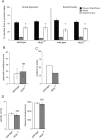Social Behavioral Deficits Coincide with the Onset of Seizure Susceptibility in Mice Lacking Serotonin Receptor 2c
- PMID: 26308619
- PMCID: PMC4550412
- DOI: 10.1371/journal.pone.0136494
Social Behavioral Deficits Coincide with the Onset of Seizure Susceptibility in Mice Lacking Serotonin Receptor 2c
Abstract
The development of social behavior is strongly influenced by the serotonin system. Serotonin 2c receptor (5-HT2cR) is particularly interesting in this context considering that pharmacological modulation of 5-HT2cR activity alters social interaction in adult rodents. However, the role of 5-HT2cR in the development of social behavior is unexplored. Here we address this using Htr2c knockout mice, which lack 5-HT2cR. We found that these animals exhibit social behavior deficits as adults but not as juveniles. Moreover, we found that the age of onset of these deficits displays similar timing as the onset of susceptibility to spontaneous death and audiogenic-seizures, consistent with the hypothesis that imbalanced excitation and inhibition (E/I) may contribute to social behavioral deficits. Given that autism spectrum disorder (ASD) features social behavioral deficits and is often co-morbid with epilepsy, and given that 5-HT2cR physically interacts with Pten, we tested whether a second site mutation in the ASD risk gene Pten can modify these phenotypes. The age of spontaneous death is accelerated in mice double mutant for Pten and Htr2c relative to single mutants. We hypothesized that pharmacological antagonism of 5-HT2cR activity in adult animals, which does not cause seizures, might modify social behavioral deficits in Pten haploinsufficient mice. SB 242084, a 5-HT2cR selective antagonist, can reverse the social behavior deficits observed in Pten haploinsufficient mice. Together, these results elucidate a role of 5-HT2cR in the modulation of social behavior and seizure susceptibility in the context of normal development and Pten haploinsufficiency.
Conflict of interest statement
Figures





References
-
- Young SN, Leyton M. The role of serotonin in human mood and social interaction. Insight from altered tryptophan levels. Pharmacology, biochemistry, and behavior. 2002;71(4):857–65. . - PubMed
-
- Higley JD, King ST Jr., Hasert MF, Champoux M, Suomi SJ, Linnoila M. Stability of interindividual differences in serotonin function and its relationship to severe aggression and competent social behavior in rhesus macaque females. Neuropsychopharmacology: official publication of the American College of Neuropsychopharmacology. 1996;14(1):67–76. 10.1016/S0893-133X(96)80060-1 . - DOI - PubMed
Publication types
MeSH terms
Substances
Grants and funding
LinkOut - more resources
Full Text Sources
Other Literature Sources
Medical
Molecular Biology Databases
Research Materials

